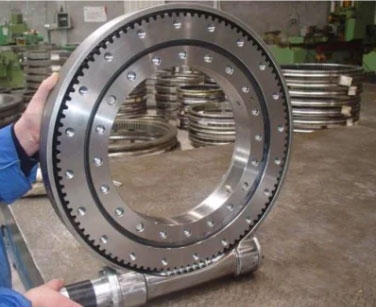Crossed cylindrical roller slewing bearings
In the realm of mechanical engineering, crossed cylindrical roller slewing bearings are known for their exceptional load-bearing capabilities, precision, and rigidity. They are widely employed in applications that demand optimal performance under heavy loads and challenging conditions. This article delves into the design, characteristics, advantages, and applications of crossed cylindrical roller slewing bearings, providing a comprehensive insight into their importance in the engineering domain.

Design and Characteristics
Crossed cylindrical roller slewing bearings comprise a set of cylindrical rollers arranged in a crossed configuration, contained within an inner and outer ring. The rings feature raceways that accommodate these rollers, which are positioned at right angles to each other. This unique design enables the bearing to support high radial, axial, and moment loads simultaneously. The primary components of these bearings include:
Inner and outer rings: The concentric rings form the base of the bearing structure, offering a stable platform for the rollers to move in.
Rolling elements: Cylindrical rollers made of high-quality materials such as steel or ceramic ensure smooth rotation between the inner and outer rings.
Cage: The cage is responsible for maintaining uniform spacing between the rollers, preventing contact during rotation and reducing friction.
Seals: Bearings may incorporate seals to safeguard the internal components from contamination and retain lubrication.
Advantages
Crossed cylindrical roller slewing bearings offer several benefits, including:
High load capacity: Their crossed roller arrangement allows for exceptional load-bearing capabilities, making them suitable for heavy-duty applications.
Rigidity and precision: The design ensures minimal deflection and deformation under heavy loads, contributing to increased precision and performance.
Space efficiency: The compact design allows for efficient use of space in applications with limited room for bearings.
Ease of installation and maintenance: These bearings are designed for straightforward installation and maintenance, reducing downtime and associated costs.
Applications
Crossed cylindrical roller slewing bearings are employed in various industries, such as:
Aerospace: In satellite and antenna systems, these bearings provide the required precision and rigidity for accurate positioning and rotation.
Machine tools: Precision machine tools, such as milling machines and lathes, rely on these bearings for their high accuracy and load-bearing capabilities.
Construction equipment: Crossed cylindrical roller slewing bearings are used in excavators, cranes, and other heavy machinery for smooth rotation and handling of substantial loads.
Industrial robots: In the field of robotics, these bearings facilitate precise movement and load handling, making them essential components in automation processes.
Medical equipment: High-precision medical devices, such as surgical robots and MRI machines, employ these bearings for their accuracy and rigidity.
Conclusion
Crossed cylindrical roller slewing bearings play a pivotal role in a wide range of applications across multiple industries. Their unique design, high load capacity, and precision make them an ideal choice for engineers and manufacturers seeking optimal performance under demanding conditions. As technology advances, crossed cylindrical roller slewing bearings will continue to serve as key components in the development of high-performance machinery and systems.











